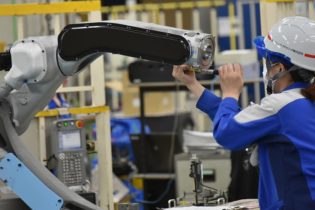Building Resilient Skills in the Face of Uncertainty

“Think about it: The pace of change has never been this fast, yet it will never be this slow again.” Justin Trudeau made this statement at the World Economic Forum in Davos in January 2018. In Valley Vision’s 21st Century Workforce impact area, we are seeing the truth of this statement over and over again. The joint pressures of coming out of one of the largest dislocations of workers in our history, the accelerated adoption of automation, and the necessity of determining a recovery strategy inclusive of our region’s diverse workforce combine to require a novel, aligned strategy to prepare our entire population for the Future of Work.
Valley Vision has been working on Future of Work strategies for several years. With funding from the Capital Region’s four workforce boards; Sacramento Employment and Training Agency, Golden Sierra Job Training Agency, North Central Counties Consortium and YoloWorks, Valley Vision has conducted research to anticipate the skills and knowledge needed for the workplace of tomorrow to ensure a ready, regional workforce including producing Automation Risk for Jobs in the Capital Region report. Through funding from the Los Rios Community College District, Valley Vision has convened advisories in specific industry and occupational sectors to identify emerging trends and ensure a workforce that meets employers’ evolving needs.
Recently, through an award from the City of Sacramento CARES funds, Valley Vision was able to embark on a research partnership with Burning Glass Technologies to analyze job posting data to identify transferable, destination occupations for community members laid off from COVID-19. This work builds off the Automation Risk for Jobs in the Capital Region report which looked at the proportion of high risk jobs within the nine county capital region and the demographics breakdown within those jobs.
As the COVID-19 pandemic hit, we saw the jobs identified at highest risk of automation experience the highest layoffs. The correlation of dislocated workers to high automation risk occupations points to the uncertainty of how many original jobs will return and the increasing need to prepare our region’s workforce for more resilient careers, able to withstand advances in automation and other market disruptions. This new research from Burning Glass Technologies identifies the specific skills needed to move job seekers from high risk positions to more stable occupations at similar or higher wages.
This information will be highlighted in a joint webinar with the City of Sacramento as we review the initial research findings. Additional information will be forthcoming, identifying the highest in demand skills for employers in our region. We invite you to stay connected to Valley Vision as we explore the Future of Work together and create pathways for all community members to benefit from our region’s shared prosperity.
To keep up with Valley Vision’s work to advance a future-ready workforce in the Sacramento region, subscribe to our 21st Century Workforce email newsletter!”
Renee John is a Valley Vision Project Leader managing initiatives within the 21st Century Workforce impact area.



